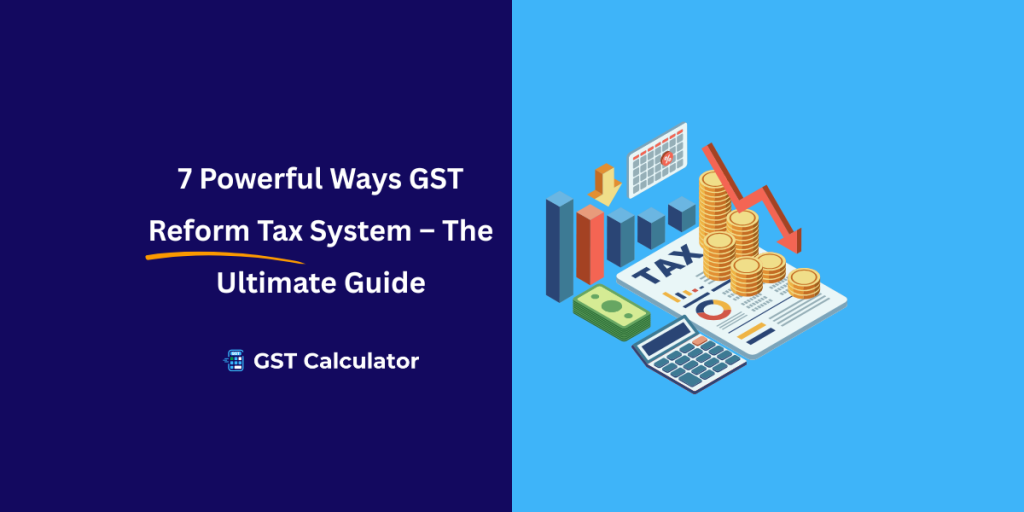Explore how Goods and Services Tax (GST) transformed India’s tax structure — benefits, challenges, reforms, and future explained clearly.
Introduction
Imagine this: it’s 2016, and Rajesh, a trader in Mumbai, is surrounded by piles of invoices and tax forms.
For every sale, he must figure out whether to apply VAT, service tax, or excise duty — each with its own rate and rules.
Every state has a different system, and his accountant looks more exhausted than his calculator.
Then came July 1, 2017 — the night Parliament introduced a new system called the Goods and Services Tax.
It wasn’t just another tax; it was a promise to simplify India’s tangled web of indirect levies into a unified, transparent structure.
Fast forward to 2025 — Rajesh now files his returns online, generates e-invoices with a click, and understands his tax liabilities clearly.
That’s the transformation this reform brought.
Let’s take a detailed look at how the Goods and Services Tax changed India’s economy forever.

1. The Birth of a Unified Tax Reform
Before this reform, India’s taxation landscape resembled a maze.
Different products were taxed differently in each state — and often multiple times along the supply chain.
Here’s what it looked like before 2017:
- Manufacturers paid excise duty to the Central Government.
- Traders paid Value Added Tax (VAT) to the State Government.
- Service providers collected service tax.
- Transporters paid entry tax or octroi while crossing borders.
This “tax-on-tax” system inflated prices and created massive confusion. Businesses often had to maintain separate books for each tax type.
The Reform Everyone Waited For
Economists had been calling for a unified indirect tax since the early 2000s.
Finally, in 2017, after years of debate, India launched the Goods and Services Tax — a comprehensive levy covering goods and services under a single umbrella.
The slogan “One Nation, One Tax, One Market” became reality.
Prime Minister Narendra Modi called it the “Good and Simple Tax,” reflecting both its purpose and optimism.
2. Simplifying a Complicated System
Before this reform, the same product could be taxed by multiple authorities.
For example, a manufacturer of soap in Gujarat would pay excise duty to the centre, VAT to the state, and possibly entry tax if transported across borders.
Now, everything falls under a single indirect tax framework.
| Old System (Before 2017) | New System (Under GST) |
|---|---|
| VAT, Service Tax, Excise, Entry Tax, Octroi | One consolidated GST |
| Multiple tax authorities | Single national portal (gst.gov.in) |
| Cascading “tax-on-tax” | Input Tax Credit removes duplication |
| Physical paperwork | Online filing and e-invoices |
| Different rules per state | Common national framework |
This single reform made India a common economic market. Businesses now compete based on quality and price — not on complex state taxes.
3. The Dual Tax Structure – A Fair Distribution Model
India adopted a dual tax model, ensuring both central and state governments share revenue fairly.
- CGST (Central Tax) – collected by the central government.
- SGST (State Tax) – collected by the respective state.
- IGST (Integrated Tax) – applied when goods or services move between states.
Example:
A company in Delhi sells furniture to a customer in Haryana.
Instead of paying separate state and central taxes, the seller now charges IGST, which is then divided between both governments.
This transparent sharing mechanism prevents double taxation and promotes fairness.
4. How the Input Tax Credit Revolutionized Compliance
One of the most powerful features of the new tax system is the Input Tax Credit (ITC).
It allows businesses to reduce their tax liability by claiming credit for the tax they paid on purchases.
Example:
If a dealer buys goods worth ₹1,00,000 and pays ₹18,000 as tax, and later sells them for ₹1,50,000 with ₹27,000 tax,
he only pays ₹9,000 to the government — because ₹18,000 is already claimed as input credit.
This eliminates the “tax-on-tax” problem and encourages businesses to maintain proper invoices, promoting transparency across the supply chain.
5. Technology – The Backbone of Modern Taxation
The introduction of a digital tax portal completely changed how businesses interact with the government.
Everything — from registration to filing returns — is handled online via the official platform.
This shift has:
- Reduced human errors
- Curbed corruption
- Made compliance faster and cheaper
Behind this transformation is the Goods and Services Tax Network (GSTN) — a massive IT system linking over 1.4 crore taxpayers with central and state authorities.
Key Digital Features:
- E-Way Bills: Track goods movement seamlessly.
- E-Invoicing: Real-time invoice validation and fraud prevention.
- Online Refunds: Automated refund claims and status tracking.
This tech-driven approach has made India’s indirect tax system one of the most advanced globally.
6. The GST Council – Democracy in Decision Making
Unlike most countries, India’s reform wasn’t driven by a single authority.
The GST Council, led by the Union Finance Minister and state finance ministers, ensures that every state has an equal voice.
How It Functions:
- Meets regularly to discuss rate changes and policies.
- Requires a 75% majority for any decision.
- Balances central and state interests fairly.
Over the years, the Council has introduced reforms like:
- Lowering rates on essential commodities.
- Launching simplified return forms for small taxpayers.
- Promoting digital filing and compliance support centers.
This cooperative model has made the tax system both flexible and inclusive.
7. How It Changed Businesses and the Economy
The new tax system didn’t just simplify accounting — it transformed India’s business landscape.
💼 For Businesses
- Reduced compliance burden: One consolidated return instead of multiple.
- Lower logistics costs: No more check posts at every state border.
- Increased efficiency: Input credits and uniform tax rates improved margins.
💰 For the Economy
- Higher transparency: Every transaction is digitally recorded.
- Broader tax base: More businesses entered the formal system.
- Boosted foreign investment: Simpler tax rules attract global investors.
📊 For Consumers
- Lower prices: Removal of cascading taxes reduced costs on several goods.
- Clarity in billing: Invoices now show exact tax breakdowns.
GST Rationalisation for Wood Industry
- GST reduced from 12% to 5% on rice husk board, glassfibre reinforced gypsum board, cement bonded particle board, jute particle board, bagasse board, sisal fibre board, etc.
- Sheets for veneering, bamboo flooring, casks, barrels, vats, tubs of wood are also included.
- The aim is to support MSMEs in wood manufacturing and promote eco-friendly alternatives.
GST Rationalisation for Handicrafts Industry
- GST cut from 12% to 5% on idols made of wood, stone, and metals.
- GST reduction also applies to paintings, drawings, original engravings, handcrafted candles, carved wood products, handbags including pouches and purses, stone art ware, stone inlay work, tableware and kitchenware of clay & terracotta.
- It further covers glass statutes, artware of iron, aluminium, brass/copper, etc.
- These reforms strengthen India’s cultural economy and young artisanal livelihoods.
The Ongoing Challenges
No major reform comes without roadblocks.
The introduction of this system had its share of challenges:
- Frequent Rule Changes: Businesses had to keep up with constant updates.
- Technical Glitches: The online portal faced heavy traffic early on.
- Multiple Tax Slabs: Created confusion in categorizing goods and services.
- Learning Curve for MSMEs: Smaller traders took time to adjust to digital compliance.
Yet, over time, consistent improvements and policy updates have stabilized the system.
Today, filing returns or claiming credits is smoother than ever.
The Future – Automation and Artificial Intelligence
The next phase of India’s tax system is automation.
Here’s what’s coming:
- AI-based compliance tracking: Detects fake invoices and fraudulent filings automatically.
- Integrated tax portals: Linking income tax and indirect tax systems for a unified taxpayer profile.
- Advanced analytics: Real-time data monitoring for better policy decisions.
- Expanded e-invoicing: Soon mandatory for all businesses, large and small.
This evolution ensures India remains future-ready while making compliance easier for everyone.
Conclusion
When the Goods and Services Tax was introduced, many feared it would complicate life further.
But over the years, it has proven to be India’s most powerful economic reform — simplifying taxes, boosting transparency, and modernizing the economy.
From Rajesh, the shopkeeper who once struggled with multiple tax forms, to big corporates managing nationwide logistics — every business now speaks the same tax language.
This system didn’t just merge old taxes; it merged India into one unified market.
And that’s the real success story — turning complexity into clarity, paperwork into pixels, and confusion into confidence.
FAQs
What is the Goods and Services Tax?
It’s a unified indirect tax replacing multiple central and state levies, applied on the supply of goods and services.
When was it implemented?
It officially started on July 1, 2017.
Who manages it?
The GST Council — comprising central and state finance ministers.
What are its main benefits?
Simplified tax structure, digital compliance, and reduced tax burden for businesses and consumers.
Does it apply to all businesses?
Most businesses with turnover above ₹40 lakhs must register, while smaller ones can opt for the composition scheme.

